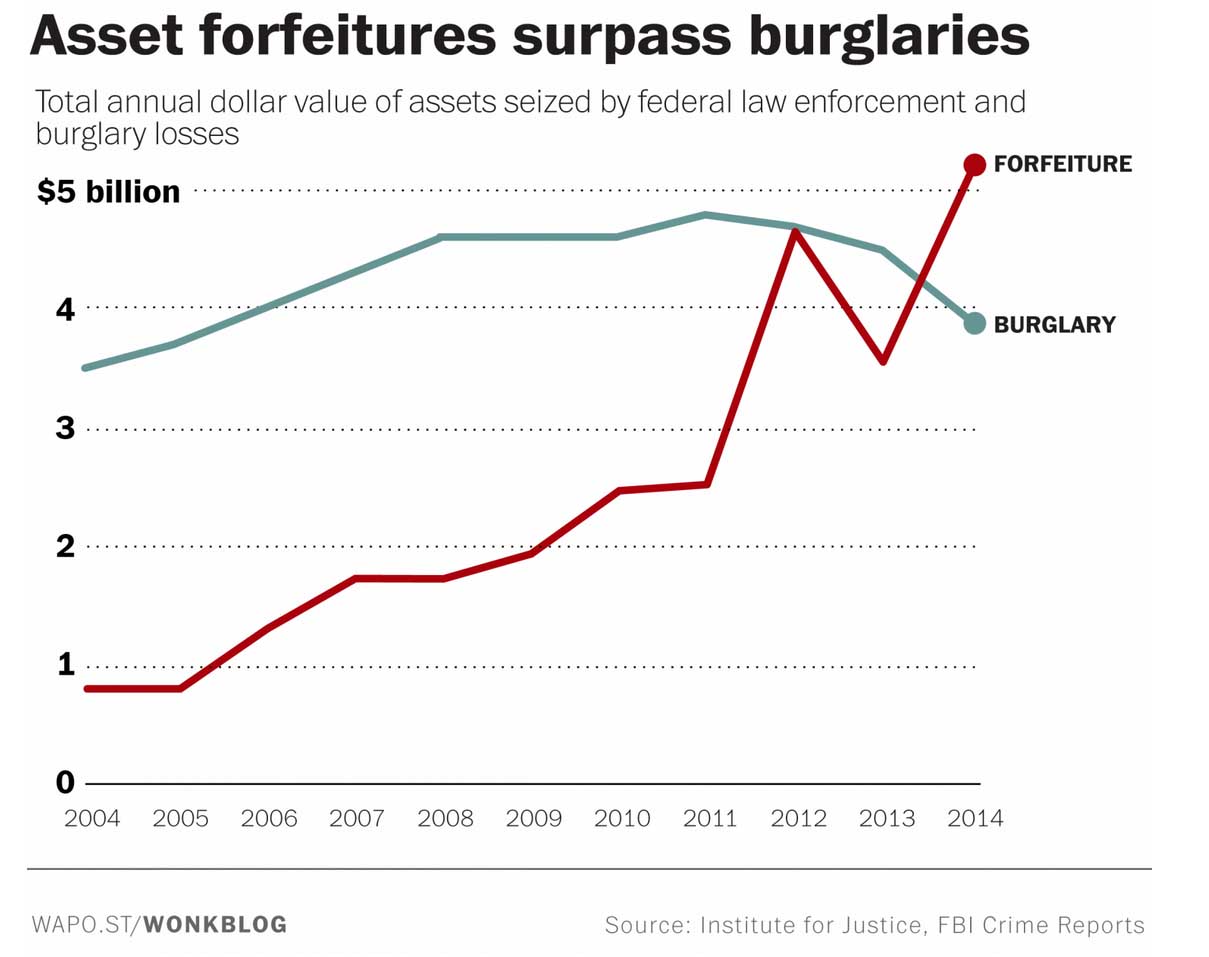by Dave Hodges
The Common Sense Show
The American economy is living on borrowed time through the infusion of massive amounts of “printed out of thin air” cash being printed by the Federal Reserve. Anyone with an IQ above room temperature knows that the inevitable economic crash is looming on the horizon.
The deficit is $19 trillion dollars, and soon-t0-be $21 trillion dollars, and that is the good news. The unfunded liabilities debt (e.g. Social Security, Medicare, etc.) is estimated to be $240 trillion dollars.
Finally, the derivatives debt that average citizens have been saddled with the burden of paying off through the infamous bailouts is now estimated to $1.5 quadrillion dollars. With the most optimistic estimates that the world’s GDP is less that $100 trillion dollars, it does no t take a rocket scientist to figure out that the ability to pay off the debt through taxation and the endless bailouts is simply not possible.
Civilian Asset Forfeiture
President Trump is way off base. He is doing great harm with his proactive support of civilian asset forfeiture.
The Federal Reserve and their colleagues know that the crash is coming. Your home, your pension, your bank account are all at risk when, not if, the crash comes. The only obstacle in the way of the public theft of private assets is the United States Constitution and the Fifth Amendment. The practice of Civilian Asset Forfeiture is setting the precedent that the government can steal all of your property.
When this practice began in the 1990’s, the amount of property stolen without due process was in the millions. Today, this practice has grown to a $4.5 billion dollar governmental criminal enterprise.
That Little Thing Called the Constitution and the Fifth Amendment
The Fifth Amendment asserts that no person shall “be deprived of life, liberty, or property, without due process of law”. Given the intended narrow definition of the Fifth Amendment, this article will demonstrate that the concept of private property is on life support and that government is attempting to separate as many private assets from its citizens as possible. One of the primary ways that the government is accomplishing this goal is through the RICO statutes and this will be the exclusive focus of this article.
What Is RICO?
The new game in America is called theft by law enforcement and RICO is the name. Much of the growth of federal criminal procedures has been tied to the expanded use of RICO. RICO stands for the Racketeer Influenced and Corrupt Organizations Act of 1970. RICO has succeeded in blurring the lines between state and federal law enforcement and in overturning the protections inherent in the guarantees of the U.S. Constitution, namely due process. As previously stated, the Fifth Amendment states that government cannot deprive citizens of life, liberty and property without due process of law. As the Patriot Act negates the Fourth Amendment protections, RICO does the same with the Fifth Amendment due process rights.
RICO is essentially the seizure of goods and assets obtained as a result of ACCUSED criminal activity.
Gangster Cops in Meridian MS.
During a traffic stop in Meridian, Mississippi, police found $360,000 tucked away in an obscure compartment of a man’s car. Certainly the amount of money in question would get our collective attention, however, the driver was let go. And if the Meridian city government has a problem with large amounts of cash, then pass a law forbidding the carrying of cash over a certain amount. Until then, this man committed no crime. In this case, the cops simply stole the man’s money.
Under RICO, law enforcement agency can seize your property, and it’s up to you to prove that the money isn’t connected to a crime. This is an obvious violation of the Fifth Amendment which requires the government to prove in court that the accused is guilty beyond a reasonable doubt.
This application of RICO is unconstitutional on its face and it is still being allowed. Why? Because RICO money is being used by the law enforcement agencies to enrich their department as well as to host lavish department/agency parties.
Your Property Is Not Safe
For those who think that the Meridian, MS. motorist got what he deserved because nobody should be carrying that kind of cash on them, consider the Russell Caswell case which demonstrates that, under RICO statutes, one can lose everything even when they have never been suspected of a crime.
Motives for RICO Enforcement
The money that law enforcement seizes, is money that goes towards the purchase of office equipment, new vehicles, larger expense accounts and the list goes on. However, agency assets are not the only destination for RICO obtained assets.
In a clear violation of the 10th Amendment, the Federal government has made local law enforcement partners in these crimes being perpetrated against the American people through the practice of “equitable sharing agreements” between the Department of Justice and local or state law enforcement. Just like a Mafia protection racket, the Feds typically are taking 10 to 20 percent of all profits connected to local seizures.
Re-instituting the Fifth Amendment
In only six states does the government assume the burden of proof that establishes the fact that the person is guilty in order to confiscate all types of property. According to the Institute for Justice, in 38 states, the burden for all forfeitures, including one’s home, falls directly upon the owner.
The simple fix to this public theft of private assets is to simply follow the Constitution in which the government, before permanently seizing assets, must first establish guilt in a court of law.
On July 28, 2014, U.S. Congressman Timothy Walberg (R-Mich.) introduced a bill intended to reform federal asset civil forfeiture laws. In the Senate, Senator Rand Paul (R-Ky.) introduced S. 2644, the FAIR (Fifth Amendment Integrity Restoration) Act, which similarly seeks to change the way the government seizes property suspected of being involved in criminal activity. The bills failed.
The chances of passage of these parallel bills in the House and the Senate are slim and none. The radical Marxist factions presently running the Democratic party will prevent passage in the Senate. And even if the bill passed in the Senate, does anyone have any doubt that President Trump will have his veto pen ready?
President Trump Approves
In a recently recorded interview, President Trump threatened to destroy the political career of a Texas legislator by introducing legislation that would require a court action to seize property.
The bill in question in Texas is SB156 from Sen. Juan Hinojosa (D-Dist. 20).









